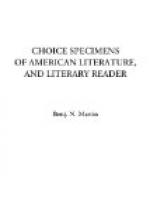Silence reigned over nature and man. Not a word
was uttered among the countless multitude that thronged
the hill-sides and plains, whilst the priest performed
his direful duty to the gods. At length, as the
fire sparks gleamed faintly from the whirling instrument,
low sobs and ejaculations were whispered among the
eager masses. As the sparks kindled into a blaze,
and the blaze into a flame, and the flaming shield
and victim were cast together on a pile of combustibles
which burst at once into the brightness of a conflagration,
the air was rent with the joyous shouts of the relieved
and panic-stricken Indians. Far and wide over
the dusky crowds beamed the blaze like a star of promise.
Myriads of upturned faces greeted it from hills, mountains,
temples, terraces, teocallis, house-tops, and city
walls; and the prostrate multitudes hailed the emblem
of light, life, and fruition, as a blessed omen of
the restored favor of their gods, and the preservation
of their race for another cycle. At regular intervals,
Indian couriers held aloft brands of resinous wood,
by which they transmitted the “New Fire”
from hand to hand, from village to village, and town
to town, throughout the Aztec empire. Light was
radiated from the imperial or ecclesiastical center
of the realm. In every temple and dwelling it
was rekindled from the sacred source; and when the
sun rose again on the following morning, the solemn
procession of priests, princes, and subjects, which
had taken up its march from the capital on the preceding
night with solemn steps, returned once more to the
abandoned capital, and, restoring the gods to their
altars, abandoned themselves to joy and festivity,
in token of gratitude and relief from impending doom.
* * * *
*
=_Albert James Pickett,[41] 1858-._= (Manual, p. 490.)
From “The History of Alabama.”
=_137._= THE INDIANS AND THE EARLY SETTLERS OF ALABAMA.
During my youthful days, I was accustomed to be much
with the Creek Indians, hundreds of whom came almost
daily to the trading-house. For twenty years
I frequently visited the Creek nation. Their green-corn
dances, ball plays, war ceremonies, and manners and
customs, are all fresh in my recollection. In
my intercourse with them I was thrown into the company
of many old white men called “Indian country
men,” who had for years conducted a commerce
with them. Some of these men had come to the
Creek nation before the Revolutionary War, and others,
being tories, had fled to it during the war, and after
it to escape from whig persecution. They were
unquestionably the shrewdest and most interesting
men with whom I ever conversed. Generally of Scotch
descent, many of them were men of some education.
All of them were married to Indian wives, and some
of them had intelligent and handsome children....
I often conversed with the chiefs while they were
seated in the shades of the spreading mulberry and
walnut, upon the banks of the beautiful Tallapoosa.
As they leisurely smoked their pipes, some of them
related to me the traditions of their country.
I occasionally saw Choctaw and Cherokee traders, and
learned much from them. I had no particular object
in view, at that time, except the gratification of
a curiosity which led me, for my own satisfaction
alone, to learn something of the early history of
Alabama.




